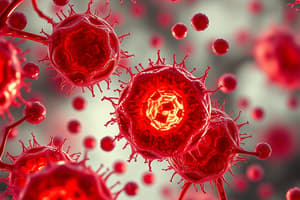Podcast
Questions and Answers
What is the reference range for Potassium in mEq/L?
What is the reference range for Potassium in mEq/L?
- 5.0-5.5
- 2.5-4.5
- 3.5-5.0 (correct)
- 4.0-6.0
Which white blood cell has a reference range of 0-1%?
Which white blood cell has a reference range of 0-1%?
- Lymphocytes
- Monocytes
- Basophils (correct)
- Eosinophils
What is the reference range for Blood Urea Nitrogen (BUN) in mg/dL?
What is the reference range for Blood Urea Nitrogen (BUN) in mg/dL?
- 3.0-10.0
- 8.0-20.0 (correct)
- 5.0-15.0
- 10.0-30.0
For anticoagulant therapy, what is the target International Normalized Ratio (INR)?
For anticoagulant therapy, what is the target International Normalized Ratio (INR)?
What is the normal reference range for Calcium in mg/dL?
What is the normal reference range for Calcium in mg/dL?
Which test has a reference range of 10-13.1 seconds?
Which test has a reference range of 10-13.1 seconds?
What is the reference range for Creatinine in mg/dL?
What is the reference range for Creatinine in mg/dL?
What is the acceptable reference range for Chloride in mEq/L?
What is the acceptable reference range for Chloride in mEq/L?
What is the reference range for the WBC count in a complete blood count?
What is the reference range for the WBC count in a complete blood count?
Which component of the complete blood count has a normal reference range of 12-18 g/dL?
Which component of the complete blood count has a normal reference range of 12-18 g/dL?
Which of the following actions is NOT part of the specimen collection role of a nurse?
Which of the following actions is NOT part of the specimen collection role of a nurse?
What is considered a critical test result that should be immediately reported?
What is considered a critical test result that should be immediately reported?
In a differential white blood cell count, what reflects a common marker for infection?
In a differential white blood cell count, what reflects a common marker for infection?
What is the reference range for a platelet count in a complete blood count?
What is the reference range for a platelet count in a complete blood count?
Which role of the nurse is essential before any imaging study is conducted?
Which role of the nurse is essential before any imaging study is conducted?
What is the normal reference range for Hematocrit levels?
What is the normal reference range for Hematocrit levels?
Study Notes
Learning Objectives
- Ability to describe commonly ordered laboratory and imaging studies
- Knowledge of normal reference values for these studies
- Understanding of critical test results and the importance of immediate reporting
Role of the Nurse
-
Specimen Collection:
- Verify orders, ensure accurate patient identification, and educate patients
- Practice proper hand hygiene during sample collection
- Label samples at the bedside to prevent errors
- Transport collected samples to the laboratory
-
Imaging Studies:
- Confirm orders and patient identification
- Prepare patients as necessary for tests
- Monitor patients post-examination as required
Laboratory Studies
- Blood Studies Overview:
- Commonly performed laboratory tests include Complete Blood Count (CBC) and Basic Metabolic Panel (BMP)
Complete Blood Count (CBC)
- Components and Reference Values:
- WBC Count: 5,000-10,000 mm³
- Hemoglobin (Hgb): 12-18 g/dL
- Hematocrit (Hct): 40-50%
- RBC Count: 4.2-5.9 million mm³
- Mean Corpuscular Volume (MCV): 80-94 fl
- Mean Corpuscular Hgb (MCH): 27-32 pg
- Mean Corpuscular Hgb Concentration (MCHC): 33-38%
- Red Cell Distribution Width (RDW): 11.5-15.0%
- Platelet Count: 100,000-400,000 mm³
Differential Count
- Neutrophils: 36-71%
- Lymphocytes: 20-50%
- Monocytes: 6-13%
- Eosinophils: 0-6%
- Basophils: 0-1%
- Band Forms: 0-1%
Basic Metabolic Panel (BMP)
- Components and Reference Ranges:
- Sodium: 135-145 mEq/L
- Potassium: 3.5-5.0 mEq/L
- Calcium: 4.5-5.1 mg/dL
- Chloride: 97-107 mEq/L
- CO2: 22-34 mmol/L
- Glucose: 60-100 mg/dL
- Blood Urea Nitrogen (BUN): 8.0-20 mg/dL
- Creatinine: 0.7-1.4 mg/dL
Complete Metabolic Panel (CMP)
- Contains 14 components, including those in the BMP
Coagulation Studies
- Prothrombin Time (PT): Reference range 10-13.1 seconds
- International Normalized Ratio (INR):
- Normal range 0.88-1.16
- 2.0-3.0 for patients on anticoagulant therapy
- 2.5-3.5 for patients with mechanical heart valves
- Partial Thromboplastin Time (PTT/aPTT): Reference range 27.5-37.4 seconds; Heparin therapy monitoring reference range 58-99 seconds
Blood Cultures
- Important to collect the first sample, followed by additional samples 15 minutes apart
Critical Values
- Certain laboratory results require immediate action and should be reported without delay to ensure appropriate patient care
Studying That Suits You
Use AI to generate personalized quizzes and flashcards to suit your learning preferences.
Related Documents
Description
Test your knowledge on the types of blood cells and their normal percentage ranges with this hematology quiz. From lymphocytes to basophils, understand their roles and significance in the blood sample analysis. Perfect for students and professionals in the medical field.




